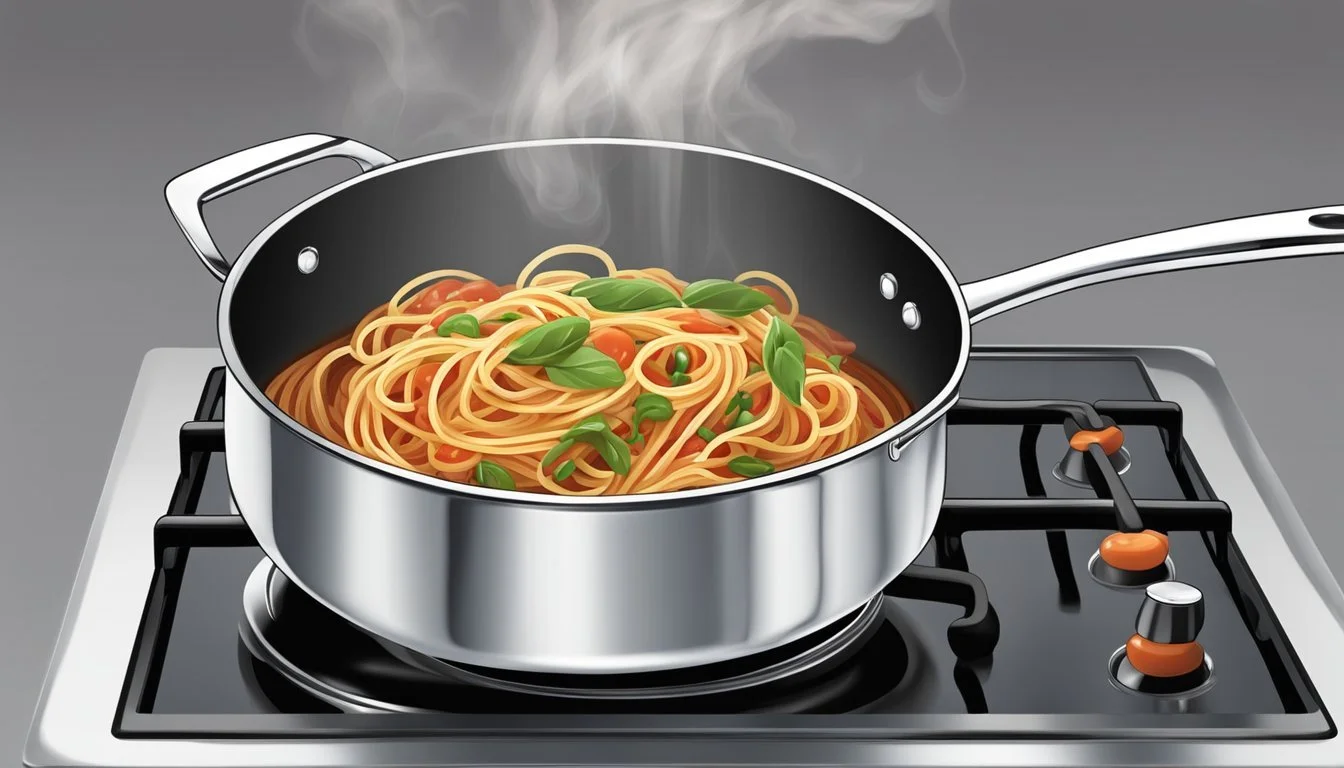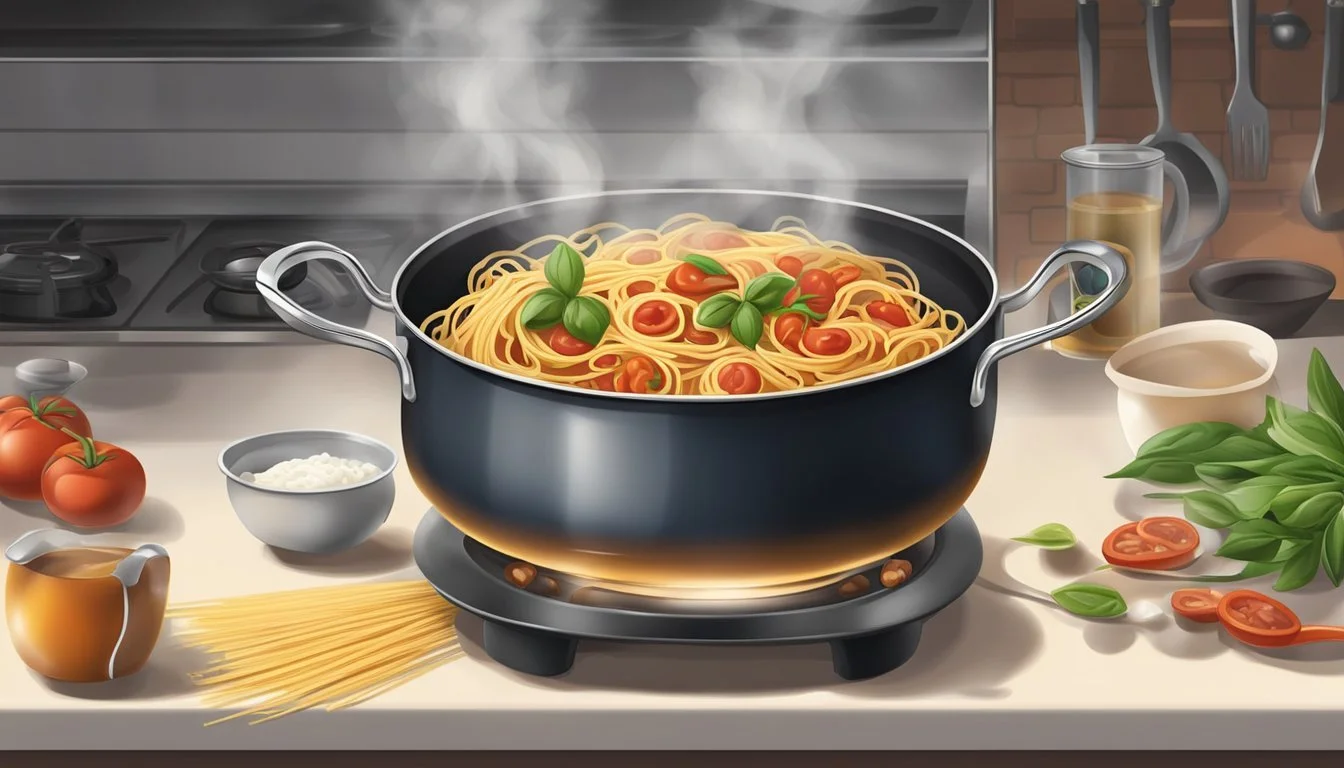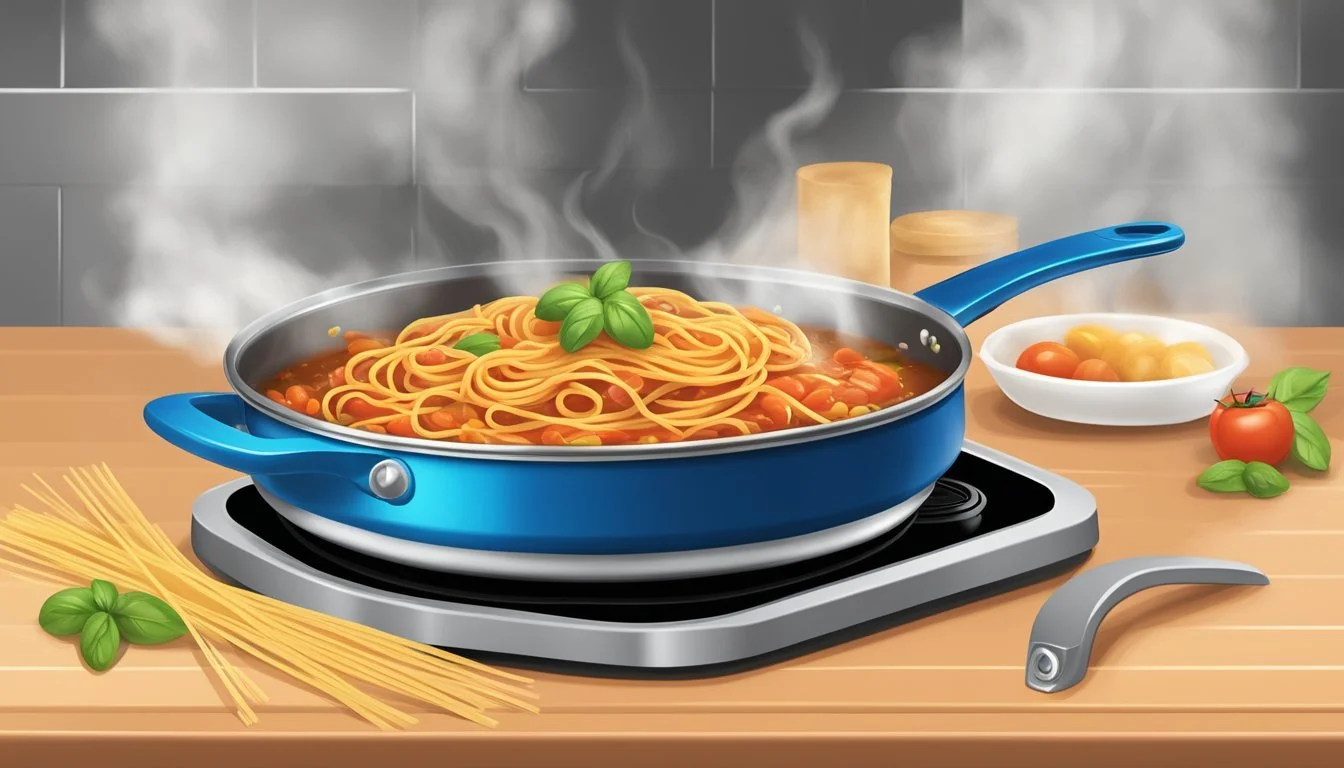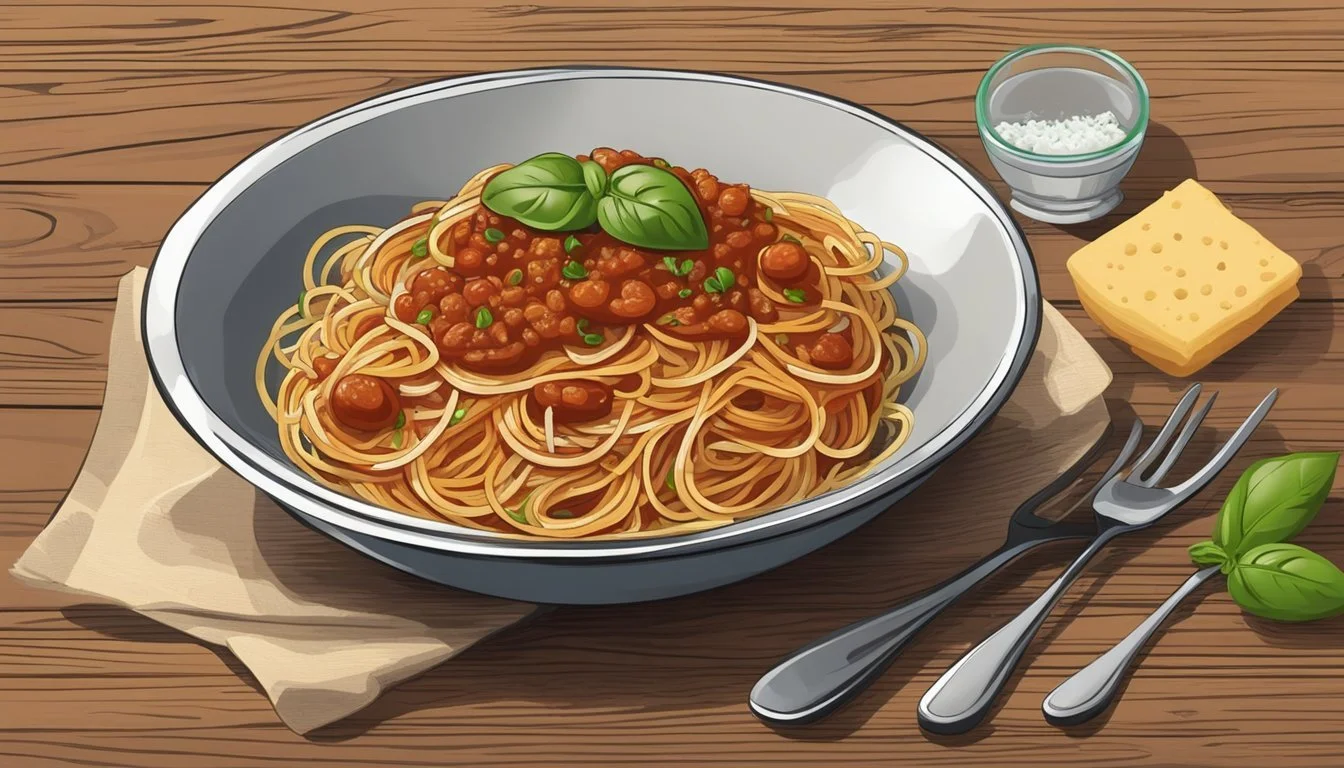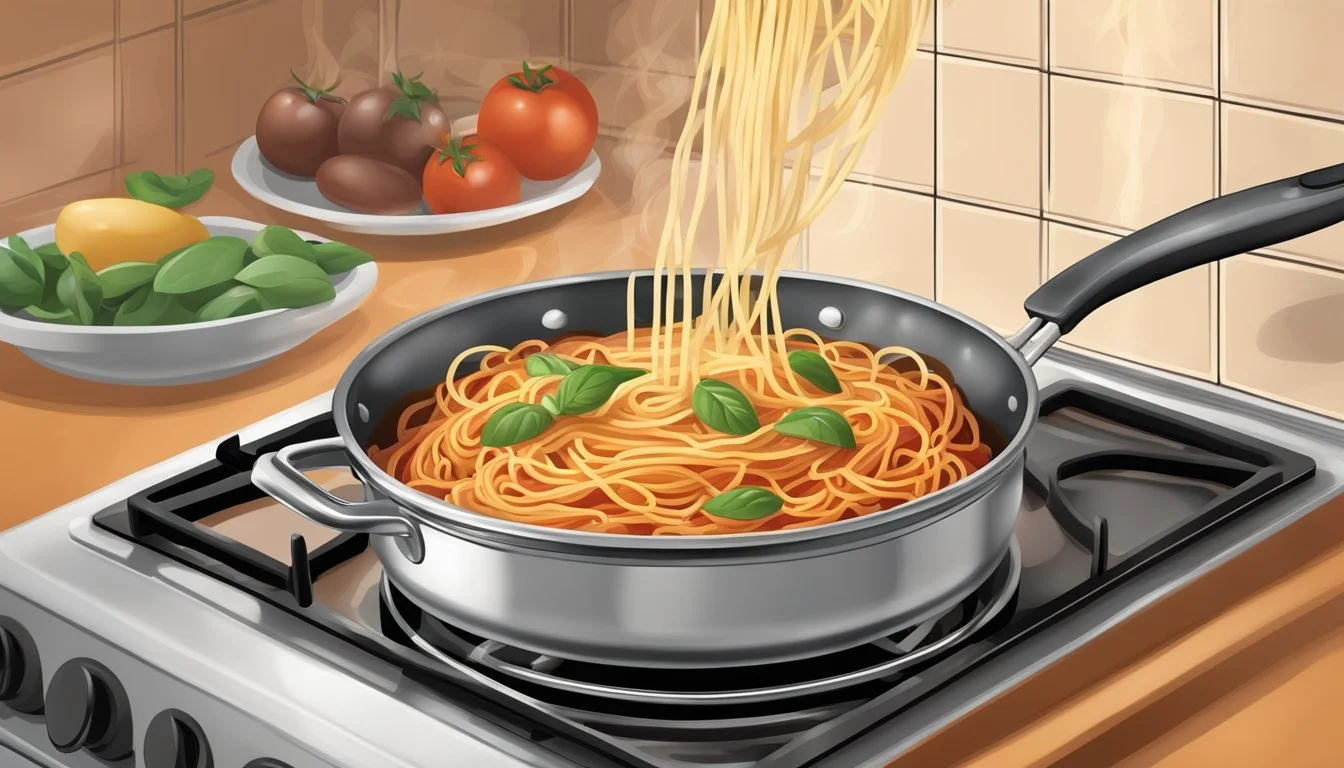Best Way to Reheat Spaghetti with Puttanesca Sauce
Ensuring Al Dente Pasta and Rich Flavors
Reheating spaghetti while maintaining its al dente texture and the rich flavors of Puttanesca sauce requires careful technique. Puttanesca sauce, known for its robust and lively flavor profile, derives its name from an Italian term suggesting a connection to "ladies of the night." However, the true focus here is the method of combining pasta (What wine goes well with pasta?) and sauce in a way that preserves the integrity of each component upon reheating.
The preferred approach is a gentle warming process that avoids overcooking the spaghetti or causing the sauce's flavors to dissipate. By employing a low heat and frequent stirring, the spaghetti can slowly reach the optimal serving temperature. This ensures the pasta does not become too soft or clump together. Additionally, properly reheating the sauce is crucial, as it needs to be heated through without losing the balance of its punchy and aromatic ingredients.
Understanding Puttanesca Sauce
Puttanesca sauce is a robust red sauce originating from Italy, renowned for its bold, umami-packed flavor. It's a staple accompaniment to pasta dishes, notably spaghetti alla puttanesca.
History and Origin
Puttanesca sauce has a storied past with roots in the mid-20th century Naples. It's said to have been a quick, flavorful sauce prepared by busy cooks from a few readily available ingredients. Despite some colorful myths surrounding its name, "puttanesca" translates to "in the style of prostitutes," the sauce's origin is not definitively linked to the ladies of the night, as often rumored. Instead, it's embraced for its ease of preparation and the deep flavors it imparts to dishes.
Key Ingredients
Central to puttanesca sauce are its key ingredients, each contributing to the sauce's characteristic taste:
Tomatoes: Typically, San Marzano tomatoes are favored for their sweet flavor and low acidity.
Olive Oil: Acts as a base and enriches the sauce with a fruity undertone.
Anchovies: Provide a salty, umami flavor that is distinctive to puttanesca.
Garlic: Adds a pungent aromatic depth to the sauce.
Olives: (What wine goes well with olives?) Black olives or Kalamata olives are commonly used, offering a briny, rich flavor.
Capers: (What wine goes well with capers?) Provide bursts of tanginess and piquancy.
Fresh Herbs: Often oregano or fresh parsley, which introduce a herbal note to balance the sauce.
This medley of ingredients, when simmered together, creates a sauce that is both hearty and complex, enhancing the overall flavor profile of the pasta dish it accompanies.
Perfecting Al Dente Spaghetti
Achieving al dente spaghetti is essential for preserving both texture and flavor when reheating with puttanesca sauce. It ensures the pasta remains firm to the bite and holds the sauce adequately.
Choosing the Right Pasta
When selecting pasta for your dish, opt for high-quality spaghetti, which typically has a better texture and flavor profile. The choice between spaghetti, vermicelli, or linguine can be a matter of personal preference, but for traditional Puttanesca, spaghetti is the standard. These pastas are long and thin, conducive to picking up the rich and briny flavors of Puttanesca sauce.
Cooking Techniques
The cooking of spaghetti follows a precise process to maintain its al dente quality:
Boil the Water: Fill a large pot with water and heat until boiling.
Salt: Add a generous pinch of salt, which seasons the pasta and can elevate the final taste.
Pasta Quantity: Add ¾ pound of spaghetti to the boiling water, ensuring there's enough space and water to prevent sticking.
Timing: Cook the spaghetti, stirring occasionally, for a duration that's usually a minute less than the package recommends, typically around 7 to 9 minutes for standard spaghetti.
Pasta Water: Before draining, reserve a cup of pasta cooking water, which can be used to adjust the sauce consistency during reheating.
The spaghetti's readiness is tested by tasting a strand — it should be firm, not hard, with a slight chew. Immediate draining and perhaps a rinse in cold water will halt the cooking process to retain the perfect texture.
Storing Leftover Spaghetti and Sauce
Proper storage of spaghetti and sauce is crucial to maintain the texture and flavor. Whether refrigerating or freezing, the key is to store pasta and sauce separately when possible.
Refrigeration Tips
When refrigerating leftover spaghetti, one should first allow it to cool at room temperature. Tossing the spaghetti with a small amount of olive oil can prevent clumping. For sauce, particularly Puttanesca which is rich in flavor, it should be stored in an airtight container to retain its savory notes. Place the sauce and pasta in separate containers to maintain the pasta's al dente texture.
Refrigerating Leftover Pasta:
Cool to room temperature.
Toss with olive oil (about 1 teaspoon per one serving of pasta).
Place in an airtight container.
Refrigerate for up to 3-4 days.
Refrigerating Leftover Puttanesca Sauce:
Cool to room temperature.
Use an airtight container to prevent absorbing other flavors.
Can be refrigerated for up to 5 days.
Freezing for Long-Term Storage
For freezing leftovers, the procedure requires more attention to preserve the integrity of the dish. Leftover spaghetti should be portioned out and can be mixed with olive oil or a bit of sauce to avoid drying out. It's best to freeze Puttanesca sauce separately in small batches to facilitate easy thawing and reheating.
Freezing Leftover Pasta:
Portion pasta and lightly coat with sauce or olive oil.
Place in freezer bags or airtight containers.
Can be frozen for up to 2 months for the best quality.
Freezing Leftover Puttanesca Sauce:
Cool down the sauce thoroughly before freezing.
Portion the sauce into usable servings.
Store in airtight containers or heavy-duty freezer bags.
Freeze for up to 4-6 months.
Always label containers with the date of storage to ensure using the leftovers within an optimal time frame. Chicken or shrimp added to the Puttanesca sauce should be consumed sooner, within 2-3 months of freezing, due to their more delicate nature.
Reheating Techniques
When reheating spaghetti with Puttanesca sauce, one aims to maintain the pasta's al dente texture and the sauce's rich flavor. The following methods detail controlled reheating to achieve that goal.
Microwave Method
For a quick reheating process, the microwave is efficient, especially for smaller portions. Place the spaghetti with sauce in a microwave-safe dish, add a splash of water to prevent drying, and cover it with a microwave-safe lid. Use a lower power setting and heat in intervals of 30 seconds, stirring in between, until the desired temperature is reached. This helps keep the pasta al dente and the sauce evenly heated.
Power Level: 50%
Time: 30-second intervals
Stir: After each interval
Stovetop Method
The stovetop method allows more control over the heat, which is beneficial for avoiding overcooking. In a pan, combine the pasta with a bit of water or additional sauce to ensure it doesn't stick or dry out. Heat on a low setting, stirring frequently. One could also reheat the sauce separately and then combine it with the pasta to distribute the flavors thoroughly.
Pan: Non-stick skillet
Heat Setting: Low
Stirring: Frequent
Oven Method
For larger quantities or to achieve a uniformly warm dish, the oven is ideal. Preheat it to 350°F (177°C). Mix the pasta with the sauce in an oven-safe dish, lightly sprinkle with water, and cover with aluminum foil to maintain moisture. Bake until the pasta is warmed through, usually for about 20 minutes, making sure the internal temperature hits 165°F (74°C) for food safety.
Temperature: 350°F (177°C)
Time: ~20 minutes
Internal Temperature: 165°F (74°C)
Retaining Sauce Flavor and Texture
When reheating spaghetti with puttanesca sauce, one must carefully manage moisture and flavor enhancement to preserve the dish's integrity. Adequate techniques ensure the pasta remains al dente and the sauce retains its robust taste.
Maintaining Moisture
To prevent the sauce from drying out during reheating, one should add a small amount of water. A tablespoon of water can be mixed with the sauce before gentle heating on the stove. If opting for a microwave, the sauce can be covered with a microwave-safe lid or a damp paper towel.
Stovetop: Add 1 tablespoon of water per cup of sauce; simmer on low heat.
Microwave: Cover with a lid or use a damp paper towel; heat for 1-1½ minutes, then in 15-second bursts as needed.
This method ensures that the moisture is retained, which is particularly important if the sauce contains fresh tomatoes or cherry tomatoes whose delicate texture can be easily compromised.
Enhancing Taste
To enhance the flavor of puttanesca sauce while reheating, one should consider using fresh ingredients. Fresh garlic cloves browned in extra virgin olive oil release an aromatic base that can be combined with the sauce. For tomato-based sauces, (What wine goes well with tomato-based sauces?) include a couple of San Marzano tomatoes or fresh cherry tomatoes to enrich the flavor.
Garlic: Sauté fresh garlic cloves in olive oil before adding to the sauce.
Tomatoes: Incorporate hand-crushed San Marzano or cherry tomatoes for a fresh burst of flavor.
The use of extra virgin olive oil is recommended for its ability to withstand heat without losing its flavor profile, which enhances the overall richness of the puttanesca sauce.
Presentation and Serving Suggestions
When serving reheated spaghetti with puttanesca sauce, the presentation should enhance the dish's vibrant colors and rich textures, while the right accompaniments can further elevate the dining experience.
Plating Techniques
To ensure the spaghetti maintains its al dente quality, it should be arranged carefully on the plate to avoid compaction. The puttanesca sauce, with its robust flavor, should be draped over the pasta in a manner that showcases the ingredients, such as capers, anchovies, and olives, offering both aesthetic appeal and a hint of the flavor profile.
Use a pasta fork or tongs to twirl a serving of spaghetti into a nest-like shape on the center of the plate.
Spoon the warm puttanesca sauce over the top, allowing some pieces of tomato, olives, and other visible elements of the sauce to rest atop the pasta.
A sprinkle of grated Parmesan cheese adds a savory touch while contributing to the visual allure.
Accompaniments
Choosing the right side dishes and garnishes can complement the flavors of spaghetti puttanesca and provide a complete meal. Freshly grated Parmesan cheese offers a salty kick that pairs beautifully with the pasta, while a garnish of fresh parsley adds a burst of color and a clean, herby contrast to the rich sauce.
Cheese: Offer a small bowl of freshly grated Parmesan cheese on the side for guests to add to their liking.
Garnishes: A light sprinkle of chopped fresh parsley not only adds freshness but also a vibrant green color that contrasts well with the red hue of the sauce.
Bread: Serve alongside slices of warm, crusty garlic bread to sop up any remaining sauce, enhancing the meal's heartiness.
Olives: A side dish of assorted olives can complement the flavors found within the sauce and serve as a palate-cleanser between bites.
Understanding Pasta and Sauce Variations
When it comes to reheating spaghetti with puttanesca sauce, considering the type of pasta and the specific adjustments for the sauce can make a noticeable difference in maintaining al dente noodles and a flavorful sauce.
Alternative Pasta Types
Spaghetti is the traditional choice for pasta puttanesca, a dish originating from the Campania region of Italy, known for its bold and umami-rich flavors alongside a spicy kick. However, one can also use variations of noodles that hold up well when reheated such as linguine, bucatini, or even zucchini noodles for a healthier twist. The key is to respect the original recipe's intention for pasta that provides a satisfying texture and carries the bright flavors of the sauce.
Traditional: Spaghetti, Linguine, Bucatini
Health-conscious alternatives: Zucchini noodles
Sauce Adjustments
Puttanesca sauce, characterized by its robust taste with ingredients like olives, capers, anchovies, and tomatoes, may require adjustments to ensure it retains its rich flavor profile upon reheating. For instance, if the sauce has become too thick after storage, a small amount of water or pasta cooking liquid can be added to bring back its silky texture. The cook should remember to heat the sauce gently to avoid separation, which can ruin the experience of a well-made puttanesca sauce recipe. Fresh ingredients can also be added just before serving to enhance the freshness and complexity of the dish.
For thickened sauce: Add water or pasta cooking liquid
For added freshness: Incorporate fresh herbs or a splash of quality olive oil before serving
Nutritional Information
When reheating spaghetti with puttanesca sauce, it is important to consider the nutritional content of the dish. This includes both the caloric content and the health benefits of the ingredients used.
Caloric Content
The caloric content of spaghetti with puttanesca sauce can vary, but a standard serving size generally contains a considerable amount of calories due to the pasta and olive oil. Ingredients like anchovies, capers, and olives contribute minimal calories in comparison to the pasta and sauce base. Typical components of puttanesca sauce and their estimated caloric contributions per serving include:
Cooked spaghetti: Approximately 220 calories per cup (140 grams)
Olive oil: Around 120 calories per tablespoon (13.5 grams)
Anchovies: Roughly 8 calories per fillet (2 grams)
Capers: About 2 calories per tablespoon (8.6 grams)
Tomatoes: Approximately 22 calories per medium tomato (123 grams)
Cheese: Varied, with Parmesan cheese having about 22 calories per tablespoon (5 grams)
Health Benefits
The ingredients in puttanesca sauce offer various health benefits. Tomatoes are rich in lycopene, an antioxidant linked to reduced risks of heart disease and cancer. Olive oil, a central component of this dish, is high in monounsaturated fats which are associated with heart health.
Olive oil: Contains monounsaturated fats and antioxidants
Capers: Provide flavonoid compounds with antioxidant properties
Anchovies: High in omega-3 fatty acids, which are essential for heart and brain health
Tomatoes: Source of vitamins C and K, potassium, and folate
Parmesan cheese: Offers calcium for bone health and proteins necessary for muscle repair
By being mindful of portion sizes and cooking methods, one can enjoy this flavorful dish while maintaining a balanced diet.
Additional Tips and Tricks
When reheating spaghetti with puttanesca sauce, it's valuable to bear in mind that the process should preserve the delicate balance of textures and flavors. One should always aim for al dente pasta and a robust sauce. Below are some nuanced strategies to achieve the best results:
Pantry Staples: Ensure to have high-quality olive oil and reserve some pasta water. The starchy water helps rejuvenate the puttanesca sauce, maintaining its consistency.
Kitchen Tools: Equip oneself with a sauté pan; it is ideal for reheating and also allows space for evenly tossing the pasta and sauce.
Reheating Technique: Gently sauté the spaghetti with a splash of pasta water or olive oil. This helps to prevent sticking and keeps the pasta tender.
Seasoning: A taste check is crucial after reheating. The sauce's seasoning may mellow, so adjust with salt, pepper, or a pinch of red pepper flakes to invigorate the flavors.
Quick Serve: If time is of essence, consider reheating individual portions rather than the whole batch. This prevents overcooking and ensures each serving is just as intended.
Crisp Appeal: For those preferring a slightly crispy texture, reheating in a hot pan without stirring too frequently can add a touch of crispiness to the edges of the pasta.
Utilizing these tips can render reheating spaghetti with puttanesca not merely a necessity, but an opportunity to revitalize a classic dish with ease and confidence.
Frequently Asked Questions (FAQs)
How do I reheat spaghetti to keep it al dente?
Reheat spaghetti by adding it to a sauté pan with a little bit of water or pasta water. Heat it on low, stirring frequently until warm. This method helps maintain the al dente texture.
Can I reheat spaghetti with Puttanesca sauce in the microwave?
Yes, in a microwave-safe dish, place a serving of spaghetti and sauce. Add a tablespoon or two of water, cover with a lid or wax paper, and microwave for 30 seconds to 1 minute. Stir and repeat if necessary, until heated through.
Is it possible to reheat spaghetti and sauce separately?
One can reheat sauce in a pan over medium heat until it simmers. For pasta, a quick dip in boiling water, for no more than 30 seconds, reinvigorates its texture.
What ingredients are essential for a flavorful Puttanesca sauce?
Key components include anchovies (or anchovy paste), garlic, capers, black olives, red pepper flakes, and canned or fresh tomatoes. These combine to create a briny, umami-rich sauce.
Are there variations to Puttanesca sauce if I don’t have the original ingredients?
Definitely. The recipe welcomes combinations like olives, canned tomatoes, and garlic, offering substantial flexibility. Variations may include adding vegetables, shrimp, or alternate herbs like fresh basil.
How can I serve reheated spaghetti with Puttanesca sauce?
Serve with a sprinkle of Parmesan cheese, a side of garlic bread, or fresh basil. For a twist, mix in proteins like shrimp for an extra savory element.
Remember, for reheat pasta and Puttanesca sauce, the key is gentle reheating to retain the flavors and texture of the original dish.


